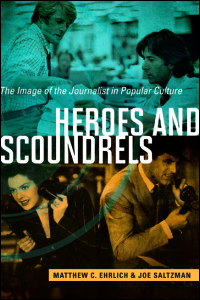
Heroes and Scoundrels:
The Image of the Journalist in Popular Culture

By Matthew C. Ehrlich
Professor of journalism at the
University of Illinois at Urbana-Champaign
and
Joe Saltzman
Professor of journalism and communication
at the University of Southern California
Publication date: April 2015. University of Illinois Press
Power
Chapter Four
Impassioned defenders and critics of journalism have one thing in common: they both assign significant responsibilities to the press. The Society of Professional Journalists (SPJ) Code of Ethics says that journalists should be “vigilant and courageous about holding those with power accountable,” and Bill Kovach and Tom Rosenstiel likewise argue in The Elements of Journalism that the press “must serve as an independent monitor of power.” For his part, media scholar and critic Robert McChesney agrees that “society needs a journalism that is a rigorous watchdog of those in power and who want to be in power” and that “can ferret out truth from lies.” Unfortunately, given that “powerful interests tend to wish to dominate the flow of information” and are consistently allowed to do so, contemporary journalism is “a failure.”
Once again we will see that popular culture plays it both ways: it depicts the press as afflicting the comfortable and comforting the afflicted, and it also depicts the press as doing the exact opposite. Journalism’s complex entanglements with political and economic power are graphically portrayed. Regardless, through a variety of character types, including the anonymous reporter, the columnist, and the publisher/media owner, the notion that the press is a uniquely potent force to do ill or good is consistently underscored.
Ehrlich-Saltzman, Heroes and Scoundrels: The Image of the Journalist in Popular Culture – page 81. ©University of Illinois Press, 2015
By venerating journalism for using its power well and vilifying it for using that power badly, popular culture offers visions in which a free press and a free people cannot be separated.
Ehrlich-Saltzman, Heroes and Scoundrels: The Image of the Journalist in Popular Culture – page 100. ©University of Illinois Press, 2015.
This chapter includes: The Press and Political Power, The Press and Economic Poweer, Columnists and Publishers-Media Barons.
Other Resources:
New TV Program: Succession
Joe Saltzman, “The Image of the Public Relations Practitioner in Movies and Television 1901–2011,” IJPC Journal 3 (Fall 2011-Spring 2012): 1–50, http://ijpc.uscannenberg.org/journal/index.php/ijpcjournal/article/view/25/50
Daxton R. Stewart, “Harry Potter and the Exploitative Jackals: Media Framing and Credibility Attitudes in Young Readers,” IJPC Journal 2 (2010): 1, 7–10, http://ijpc.uscannenberg.org/journal/index.php/ijpcjournal/article/view/18/26
Malice in Wonderland:http://ijpc.org/uploads/files/Hedda%20Hopper%20and%20Louella%20Parsons%20--%20Gossip%20Columnists.pdf
Britt Reid, owner and publisher of The Daily Sentinel (The Green Hornet).
Check out the other chapters: